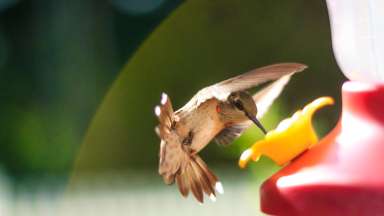Ruby-throated Hummingbirds have arrived! Our only native hummer, the ruby-throated hummingbird spends its summers here in the eastern half of North America, arriving in the Raleigh area around the end of March. It leaves to spend the winter in Central America in October.
Our area’s tiniest bird, the ruby-throated hummingbird weighs about as much as a penny. Males have the spectacular red chin that gives this species its name. (Females are green and white without the red chin)
While nesting here in the summer, the female builds a nest about 2 inches across from plant material that she stitches together with spider webs. She will lay 2 white eggs about the size of a Jelly Belly jellybean or a Tic Tac.
Hummingbird Facts
- Hummingbirds beat their wings about 70 times each second. How many times can you flap your arms in a second?
- Hummingbirds breathe about 250 times each minute. You breathe 12-20 times a minute.
- Hummingbirds can fly over 1200 miles without stopping. That’s nearly 50 hours non-stop!
- There are over 330 species of hummingbirds! All are in North, Central, and South America.
- A few species of hummingbirds that spend summers in the western half of North America, have been documented over-wintering here in North Carolina
Invite a Hummingbird to Dinner
You can welcome hummingbirds to your home by hanging nectar feeders and by planting native wildflowers that hummingbirds gather nectar from. While it is easiest to hang a feeder, hummingbirds are also valuable pollinators to nectar-producing flowers. Look for flowers that are brightly colored and tubular such as cardinal flower, native honeysuckle, bee balm, and salvias.
Here is an easy recipe to make nectar for a feeder you can buy in the store. Remember: you don’t need food coloring in the nectar. Food coloring can actually be harmful, and the red color of the feeder is all you need to attract a hummer. Just two ingredients: 2 cups of clean water and 1/2 cup of sugar. Put the water and sugar in a saucepan. Heat to boiling. Boil for one minute and then remove from heat. Let it cool to room temperature before filling the feeders. Clean the feeders and replace with fresh nectar once or twice a week.
